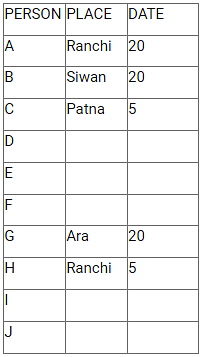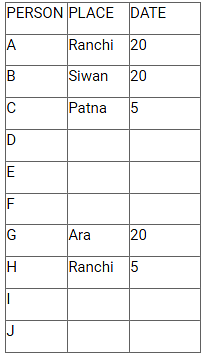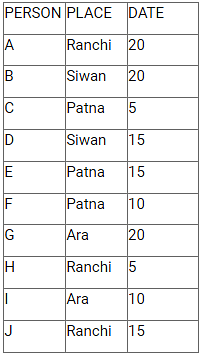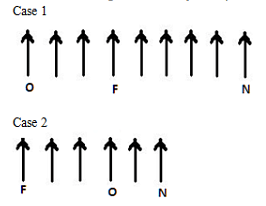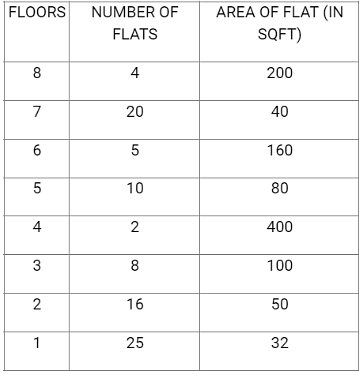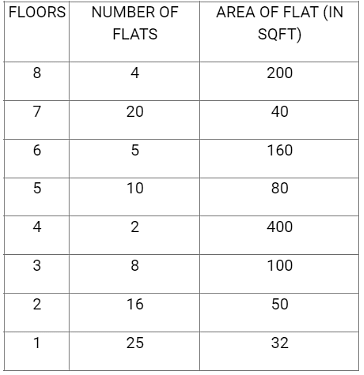IBPS PO Mains Mock Test - 3 - Bank Exams MCQ
30 Questions MCQ Test Mock Tests for Banking Exams 2024 - IBPS PO Mains Mock Test - 3
Direction: Read the following information carefully and answer the question given below-
There are some people in a family. Olivia is the grandmother of Mia. Thomas is the husband of Sophia who is sister in law of Ava. Christopher is the maternal uncle of James and Henry. Jacob is the father of Charlie. Christopher is the uncle of Evelyn. Evelyn is the granddaughter of Olivia. Christopher is the brother of Charlie who is the husband of Ava. Mia and Evelyn is the Daughter of Ava. James & Henry is the son of Thomas.
Q. How is Christopher related to Evelyn?
Direction: Read the following information carefully and answer the question given below-
There are some people in a family. Olivia is the grandmother of Mia. Thomas is the husband of Sophia who is sister in law of Ava. Christopher is the maternal uncle of James and Henry. Jacob is the father of Charlie. Christopher is the uncle of Evelyn. Evelyn is the granddaughter of Olivia. Christopher is the brother of Charlie who is the husband of Ava. Mia and Evelyn is the Daughter of Ava. James & Henry is the son of Thomas.
Q. How many male members are there?
| 1 Crore+ students have signed up on EduRev. Have you? Download the App |
Direction: Read the following information carefully and answer the question given below-
There are some people in a family. Olivia is the grandmother of Mia. Thomas is the husband of Sophia who is sister in law of Ava. Christopher is the maternal uncle of James and Henry. Jacob is the father of Charlie. Christopher is the uncle of Evelyn. Evelyn is the granddaughter of Olivia. Christopher is the brother of Charlie who is the husband of Ava. Mia and Evelyn is the Daughter of Ava. James & Henry is the son of Thomas.
Q. If Jackie is the wife of James then how is Henry related to Jackie?
Direction: Read the following information carefully and answer the question given below-
There are some people in a family. Olivia is the grandmother of Mia. Thomas is the husband of Sophia who is sister in law of Ava. Christopher is the maternal uncle of James and Henry. Jacob is the father of Charlie. Christopher is the uncle of Evelyn. Evelyn is the granddaughter of Olivia. Christopher is the brother of Charlie who is the husband of Ava. Mia and Evelyn is the Daughter of Ava. James & Henry is the son of Thomas.
Q. How is Ava related to Jacob?
Direction: Read the following information carefully and answer the question given below-
There are some people in a family. Olivia is the grandmother of Mia. Thomas is the husband of Sophia who is sister in law of Ava. Christopher is the maternal uncle of James and Henry. Jacob is the father of Charlie. Christopher is the uncle of Evelyn. Evelyn is the granddaughter of Olivia. Christopher is the brother of Charlie who is the husband of Ava. Mia and Evelyn is the Daughter of Ava. James & Henry is the son of Thomas.
Q. Who is the father of Evelyn?
Direction: Below in each question are given some statements. These statements may be either independent causes or may be effects of independent causes or a common cause. One of these statements may be the effect of the other statement. Read both the statements and decide which of the following answer choice correctly depicts the relationship between these statements.
I. The standard of living in the Indian setup has seen a sharp rise along with a marked increase in consumer spending over the past few years.
II. The gross domestic income has seen a fluctuation in the past few years which might not bode well for the Indian economy at large.
Direction: Below in each question are given some statements. These statements may be either independent causes or may be effects of independent causes or a common cause. One of these statements may be the effect of the other statement. Read both the statements and decide which of the following answer choice correctly depicts the relationship between these statements.
I. In urban areas, the poor bear the brunt of environmental effects such as water or air pollution.
II. The rapid urban development has outpaced the development of environmental infrastructure in many large cities.
III. Just for the own sake of profit, builders in urban areas are indulge in construction work without tendering about the environment and urban poor, who mostly dies from chronicle diseases.
Direction: Read the following information carefully and answer the question given below-
Ten friends A,B,C,D,E,F,G,H,I and J travel to different cities namely Ranchi, Patna, Siwan and Ara on four different dates such as 5,10,15 and 20 of a month but not necessarily in the same order. No two persons travelling the same city travel on the same date. Minimum of two persons travels one city. At least two people travel on the same date.
A is travelling to Ranchi on 20. one people travel between A and C. C either travels to Patna or Ranchi. H travels to Ranchi on 5. E and F both travel to Patna but none of them travels on 20. J travels on 15 of the month. I travel to Ara either on 10 or 20 of the month. B travels to Siwan on 20. G travels on 20. E travels on 15. The one travelling to Siwan leaves on 15 of the month. G travels to Ara. D travels to Siwan. Three people travel to Ranchi.
Q. Which of the following pairs travel to Siwan?
Direction: Read the following information carefully and answer the question given below-
Ten friends A,B,C,D,E,F,G,H,I and J travel to different cities namely Ranchi, Patna, Siwan and Ara on four different dates such as 5,10,15 and 20 of a month but not necessarily in the same order. No two persons travelling the same city travel on the same date. Minimum of two persons travels one city. At least two people travel on the same date.
A is travelling to Ranchi on 20. one people travel between A and C. C either travels to Patna or Ranchi. H travels to Ranchi on 5. E and F both travel to Patna but none of them travels on 20. J travels on 15 of the month. I travel to Ara either on 10 or 20 of the month. B travels to Siwan on 20. G travels on 20. E travels on 15. The one travelling to Siwan leaves on 15 of the month. G travels to Ara. D travels to Siwan. Three people travel to Ranchi.
Q. I travels on which date?
Direction: Read the following information carefully and answer the question given below-
Ten friends A,B,C,D,E,F,G,H,I and J travel to different cities namely Ranchi, Patna, Siwan and Ara on four different dates such as 5,10,15 and 20 of a month but not necessarily in the same order. No two persons travelling the same city travel on the same date. Minimum of two persons travels one city. At least two people travel on the same date.
A is travelling to Ranchi on 20. one people travel between A and C. C either travels to Patna or Ranchi. H travels to Ranchi on 5. E and F both travel to Patna but none of them travels on 20. J travels on 15 of the month. I travel to Ara either on 10 or 20 of the month. B travels to Siwan on 20. G travels on 20. E travels on 15. The one travelling to Siwan leaves on 15 of the month. G travels to Ara. D travels to Siwan. Three people travel to Ranchi.
Q. How many people travel patna?
Direction: Read the following information carefully and answer the question given below-
Ten friends A,B,C,D,E,F,G,H,I and J travel to different cities namely Ranchi, Patna, Siwan and Ara on four different dates such as 5,10,15 and 20 of a month but not necessarily in the same order. No two persons travelling the same city travel on the same date. Minimum of two persons travels one city. At least two people travel on the same date.
A is travelling to Ranchi on 20. one people travel between A and C. C either travels to Patna or Ranchi. H travels to Ranchi on 5. E and F both travel to Patna but none of them travels on 20. J travels on 15 of the month. I travel to Ara either on 10 or 20 of the month. B travels to Siwan on 20. G travels on 20. E travels on 15. The one travelling to Siwan leaves on 15 of the month. G travels to Ara. D travels to Siwan. Three people travel to Ranchi.
Q. How many people travel on 5 of the month?
Direction: Read the following information carefully and answer the question given below-
Ten friends A,B,C,D,E,F,G,H,I and J travel to different cities namely Ranchi, Patna, Siwan and Ara on four different dates such as 5,10,15 and 20 of a month but not necessarily in the same order. No two persons travelling the same city travel on the same date. Minimum of two persons travels one city. At least two people travel on the same date.
A is travelling to Ranchi on 20. one people travel between A and C. C either travels to Patna or Ranchi. H travels to Ranchi on 5. E and F both travel to Patna but none of them travels on 20. J travels on 15 of the month. I travel to Ara either on 10 or 20 of the month. B travels to Siwan on 20. G travels on 20. E travels on 15. The one travelling to Siwan leaves on 15 of the month. G travels to Ara. D travels to Siwan. Three people travel to Ranchi.
Q. F travels to which city?
Direction: In the following questions, a statement is followed by some courses of action. Assume everything in the statement to be true, and decide which of the suggested courses of action logically follows for pursuing.
Statement:
According to recent reports, more than two-thirds vehicles of a recently launched model of the brand X were recalled due to a major exhaust issue.
Course of Action:
I. Brand X should stop the production temporarily and focus on rectifying the problem.
II. Brand X should ignore the problem and focus on its more popular models in the market
III. Customers of Brand X should be advised to switch to a newer player in the market – Brand Y till the time being.
Direction: In the following questions, a statement is followed by some courses of action. Assume everything in the statement to be true, and decide which of the suggested courses of action logically follows for pursuing.
Statement:
Recently launched Model X of a popular Smartphone Company has major issues in camera and speaker etc.
Course of Action:
I. The company should refrain from launching new models in the near future.
II. The company should issue an apology to the customers and advise them against using it.
III. The company should discontinue the manufacture of Model X immediately.
Direction: Read the following information carefully and answer the question given below-
Few people sit on a straight line and belong to four different countries namely India, Nepal, Bhutan and Maldives. Minimum three people belong to same country. Some of them face north while some face south. A and B sit at the extreme end, both face the same direction and belong to the same country. Three people sit between A and Q. Q sits fourth to the left of A and belongs to India. The immediate neighbours of Z face the same direction as Z and belong to the same country as Z. T is immediate neighbour of Z and faces south. Five people sit between A and T. Both P and R face north. B faces south and belongs to Maldives. P and R are immediate neighbours of each other. X sits fourth to the right of B and belongs to Bhutan. Two people sit between X and S. Y is an immediate neighbour of S and sits to immediate right of S. Two people sit between Y and W. W sits second left to V and belongs to Bhutan. W faces south. X sits to immediate right of U. P is an immediate neighbour of A, who belongs to Maldives. V is an immediate neighbour of B and belongs to Nepal. P belongs to Bhutan. Y belongs to Maldives. Four people belong to Nepal.
Q. How many people face north?
Direction: Read the following information carefully and answer the question given below-
Few people sit on a straight line and belong to four different countries namely India, Nepal, Bhutan and Maldives. Minimum three people belong to same country. Some of them face north while some face south. A and B sit at the extreme end, both face the same direction and belong to the same country. Three people sit between A and Q. Q sits fourth to the left of A and belongs to India. The immediate neighbours of Z face the same direction as Z and belong to the same country as Z. T is immediate neighbour of Z and faces south. Five people sit between A and T. Both P and R face north. B faces south and belongs to Maldives. P and R are immediate neighbours of each other. X sits fourth to the right of B and belongs to Bhutan. Two people sit between X and S. Y is an immediate neighbour of S and sits to immediate right of S. Two people sit between Y and W. W sits second left to V and belongs to Bhutan. W faces south. X sits to immediate right of U. P is an immediate neighbour of A, who belongs to Maldives. V is an immediate neighbour of B and belongs to Nepal. P belongs to Bhutan. Y belongs to Maldives. Four people belong to Nepal.
Q. How many persons sit between S and W?
Direction: Read the following information carefully and answer the question given below-
Few people sit on a straight line and belong to four different countries namely India, Nepal, Bhutan and Maldives. Minimum three people belong to same country. Some of them face north while some face south. A and B sit at the extreme end, both face the same direction and belong to the same country. Three people sit between A and Q. Q sits fourth to the left of A and belongs to India. The immediate neighbours of Z face the same direction as Z and belong to the same country as Z. T is immediate neighbour of Z and faces south. Five people sit between A and T. Both P and R face north. B faces south and belongs to Maldives. P and R are immediate neighbours of each other. X sits fourth to the right of B and belongs to Bhutan. Two people sit between X and S. Y is an immediate neighbour of S and sits to immediate right of S. Two people sit between Y and W. W sits second left to V and belongs to Bhutan. W faces south. X sits to immediate right of U. P is an immediate neighbour of A, who belongs to Maldives. V is an immediate neighbour of B and belongs to Nepal. P belongs to Bhutan. Y belongs to Maldives. Four people belong to Nepal.
Q. Who sits second right to Q?
Direction: Read the following information carefully and answer the question given below-
Few people sit on a straight line and belong to four different countries namely India, Nepal, Bhutan and Maldives. Minimum three people belong to same country. Some of them face north while some face south. A and B sit at the extreme end, both face the same direction and belong to the same country. Three people sit between A and Q. Q sits fourth to the left of A and belongs to India. The immediate neighbours of Z face the same direction as Z and belong to the same country as Z. T is immediate neighbour of Z and faces south. Five people sit between A and T. Both P and R face north. B faces south and belongs to Maldives. P and R are immediate neighbours of each other. X sits fourth to the right of B and belongs to Bhutan. Two people sit between X and S. Y is an immediate neighbour of S and sits to immediate right of S. Two people sit between Y and W. W sits second left to V and belongs to Bhutan. W faces south. X sits to immediate right of U. P is an immediate neighbour of A, who belongs to Maldives. V is an immediate neighbour of B and belongs to Nepal. P belongs to Bhutan. Y belongs to Maldives. Four people belong to Nepal.
Q. Total seats in the row?
Direction: Read the following information carefully and answer the question given below-
Few people sit on a straight line and belong to four different countries namely India, Nepal, Bhutan and Maldives. Minimum three people belong to same country. Some of them face north while some face south. A and B sit at the extreme end, both face the same direction and belong to the same country. Three people sit between A and Q. Q sits fourth to the left of A and belongs to India. The immediate neighbours of Z face the same direction as Z and belong to the same country as Z. T is immediate neighbour of Z and faces south. Five people sit between A and T. Both P and R face north. B faces south and belongs to Maldives. P and R are immediate neighbours of each other. X sits fourth to the right of B and belongs to Bhutan. Two people sit between X and S. Y is an immediate neighbour of S and sits to immediate right of S. Two people sit between Y and W. W sits second left to V and belongs to Bhutan. W faces south. X sits to immediate right of U. P is an immediate neighbour of A, who belongs to Maldives. V is an immediate neighbour of B and belongs to Nepal. P belongs to Bhutan. Y belongs to Maldives. Four people belong to Nepal.
Q. How many people face south?
Direction: Read the following information carefully and answer the question given below-
A certain number of people are sitting in a straight line facing north. N sits fifth to right of F. Only two persons sit between F and O. H sits seventh to the left of O. G sits to the right of H. The number of persons sitting between O and N is one less than that between H and G. P sits between O and G. P is not an immediate neighbour of F. J sits seventh to the right of P. J sits at an extreme end of the line. As many persons sit between J and N as to the left of H.
Q. What is the position of F with respect to the person who sits second to left of N ?
Direction: Read the following information carefully and answer the question given below-
A certain number of people are sitting in a straight line facing north. N sits fifth to right of F. Only two persons sit between F and O. H sits seventh to the left of O. G sits to the right of H. The number of persons sitting between O and N is one less than that between H and G. P sits between O and G. P is not an immediate neighbour of F. J sits seventh to the right of P. J sits at an extreme end of the line. As many persons sit between J and N as to the left of H.
Q. Which of the following statements is true ?
Direction: Read the following information carefully and answer the question given below-
A certain number of people are sitting in a straight line facing north. N sits fifth to right of F. Only two persons sit between F and O. H sits seventh to the left of O. G sits to the right of H. The number of persons sitting between O and N is one less than that between H and G. P sits between O and G. P is not an immediate neighbour of F. J sits seventh to the right of P. J sits at an extreme end of the line. As many persons sit between J and N as to the left of H.
Q. How many people sit between H and J ?
Direction: Read the following information carefully and answer the question given below-
There are different numbers of flats in each floor of an eight-storey building. The lowermost floor of the building is numbered one, the one above that is numbered two and so till the topmost floor is numbered eight. Area of the floor is 800sqft i.e. which is equal for each floor. Floor 5 has 10 numbers of flats. The floor that contains 8 flats is below the floor that contains 10 flats. Only two flats are between the floor that contains 20 flats and flat which has an area of 400sqft each. The flat which has an area of 32sqft each is either at the lowermost or topmost floor. Floor 6 contains 5 flats. Floor 7 contains flat which has an area of 40sqft each. There are two floors between the floor that contains 2 flats and that contains 25 flats. The floor that contains 8 flats is above the floor that contains 16 flats. The floor that contains 4 flats is just above the floor that contains 20 flats.
Q. How many floors are there between the floor that contains 10 flats and 25 flats?
Direction: Read the following information carefully and answer the question given below-
There are different numbers of flats in each floor of an eight-storey building. The lowermost floor of the building is numbered one, the one above that is numbered two and so till the topmost floor is numbered eight. Area of the floor is 800sqft i.e. which is equal for each floor. Floor 5 has 10 numbers of flats. The floor that contains 8 flats is below the floor that contains 10 flats. Only two flats are between the floor that contains 20 flats and flat which has an area of 400sqft each. The flat which has an area of 32sqft each is either at the lowermost or topmost floor. Floor 6 contains 5 flats. Floor 7 contains flat which has an area of 40sqft each. There are two floors between the floor that contains 2 flats and that contains 25 flats. The floor that contains 8 flats is above the floor that contains 16 flats. The floor that contains 4 flats is just above the floor that contains 20 flats.
Q. Flat which has an area of 50sqft is on which floor?
Direction: Read the following information carefully and answer the question given below-
There are different numbers of flats in each floor of an eight-storey building. The lowermost floor of the building is numbered one, the one above that is numbered two and so till the topmost floor is numbered eight. Area of the floor is 800sqft i.e. which is equal for each floor. Floor 5 has 10 numbers of flats. The floor that contains 8 flats is below the floor that contains 10 flats. Only two flats are between the floor that contains 20 flats and flat which has an area of 400sqft each. The flat which has an area of 32sqft each is either at the lowermost or topmost floor. Floor 6 contains 5 flats. Floor 7 contains flat which has an area of 40sqft each. There are two floors between the floor that contains 2 flats and that contains 25 flats. The floor that contains 8 flats is above the floor that contains 16 flats. The floor that contains 4 flats is just above the floor that contains 20 flats.
Q. How many flats are on the topmost floor?
Direction: Read the following information carefully and answer the question given below-
There are different numbers of flats in each floor of an eight-storey building. The lowermost floor of the building is numbered one, the one above that is numbered two and so till the topmost floor is numbered eight. Area of the floor is 800sqft i.e. which is equal for each floor. Floor 5 has 10 numbers of flats. The floor that contains 8 flats is below the floor that contains 10 flats. Only two flats are between the floor that contains 20 flats and flat which has an area of 400sqft each. The flat which has an area of 32sqft each is either at the lowermost or topmost floor. Floor 6 contains 5 flats. Floor 7 contains flat which has an area of 40sqft each. There are two floors between the floor that contains 2 flats and that contains 25 flats. The floor that contains 8 flats is above the floor that contains 16 flats. The floor that contains 4 flats is just above the floor that contains 20 flats.
Q. What is the area of the flat at the topmost floor?
Direction: Read the following information carefully and answer the question given below-
There are different numbers of flats in each floor of an eight-storey building. The lowermost floor of the building is numbered one, the one above that is numbered two and so till the topmost floor is numbered eight. Area of the floor is 800sqft i.e. which is equal for each floor. Floor 5 has 10 numbers of flats. The floor that contains 8 flats is below the floor that contains 10 flats. Only two flats are between the floor that contains 20 flats and flat which has an area of 400sqft each. The flat which has an area of 32sqft each is either at the lowermost or topmost floor. Floor 6 contains 5 flats. Floor 7 contains flat which has an area of 40sqft each. There are two floors between the floor that contains 2 flats and that contains 25 flats. The floor that contains 8 flats is above the floor that contains 16 flats. The floor that contains 4 flats is just above the floor that contains 20 flats.
Q. Flat which has an area of 100sqft is on which floor?
Direction: Read the following information carefully and answer the question given below-
When a word and number arrangement machine is given an input line of words and numbers, it arranges them following a particular rule. The following is an illustration of input and its rearrangement.
Input: 24 Inbox 11 Starred 48 Draft 31 Sent 23 Mail 72 Spam
Step I: Draft 24 Inbox 11 Starred 48 31 Sent 23 Mail Spam 72
Step II: Inbox Draft 24 Starred 48 31 Sent 23 Mail Spam 72 11
Step III: Mail Inbox Draft 24 Starred 31 Sent 23 Spam 72 11 48
Step IV: Starred Mail Inbox Draft 24 31 Sent Spam 72 11 48 23
Step V: Sent Starred Mail Inbox Draft 31 Spam 72 11 48 23 24
Step VI: Spam Sent Starred Mail Inbox Draft 72 11 48 23 24 31
Step VI is the last step of the above arrangement as the intended arrangement is obtained.
As per the rules followed in the given steps find out the appropriate steps for the given input.
Input:- 35 Odisha 22 Mizoram 57 Meghalaya 68 Manipur 79 Assam 46 Uttarakhand
Q. What is the difference between the element which is sixth from left in Step IV and first from right in Step II?
Direction: Read the following information carefully and answer the question given below-
When a word and number arrangement machine is given an input line of words and numbers, it arranges them following a particular rule. The following is an illustration of input and its rearrangement.
Input: 24 Inbox 11 Starred 48 Draft 31 Sent 23 Mail 72 Spam
Step I: Draft 24 Inbox 11 Starred 48 31 Sent 23 Mail Spam 72
Step II: Inbox Draft 24 Starred 48 31 Sent 23 Mail Spam 72 11
Step III: Mail Inbox Draft 24 Starred 31 Sent 23 Spam 72 11 48
Step IV: Starred Mail Inbox Draft 24 31 Sent Spam 72 11 48 23
Step V: Sent Starred Mail Inbox Draft 31 Spam 72 11 48 23 24
Step VI: Spam Sent Starred Mail Inbox Draft 72 11 48 23 24 31
Step VI is the last step of the above arrangement as the intended arrangement is obtained.
As per the rules followed in the given steps find out the appropriate steps for the given input.
Input:- 35 Odisha 22 Mizoram 57 Meghalaya 68 Manipur 79 Assam 46 Uttarakhand
Q. In which of the following step the elements “57 79 Uttarakhand” found in the same order?
Direction: Read the following information carefully and answer the question given below-
When a word and number arrangement machine is given an input line of words and numbers, it arranges them following a particular rule. The following is an illustration of input and its rearrangement.
Input: 24 Inbox 11 Starred 48 Draft 31 Sent 23 Mail 72 Spam
Step I: Draft 24 Inbox 11 Starred 48 31 Sent 23 Mail Spam 72
Step II: Inbox Draft 24 Starred 48 31 Sent 23 Mail Spam 72 11
Step III: Mail Inbox Draft 24 Starred 31 Sent 23 Spam 72 11 48
Step IV: Starred Mail Inbox Draft 24 31 Sent Spam 72 11 48 23
Step V: Sent Starred Mail Inbox Draft 31 Spam 72 11 48 23 24
Step VI: Spam Sent Starred Mail Inbox Draft 72 11 48 23 24 31
Step VI is the last step of the above arrangement as the intended arrangement is obtained.
As per the rules followed in the given steps find out the appropriate steps for the given input.
Input:- 35 Odisha 22 Mizoram 57 Meghalaya 68 Manipur 79 Assam 46 Uttarakhand
Q. Which element is 6th to the right of the one which is 4th to the left element in step I ?
|
160 tests
|







